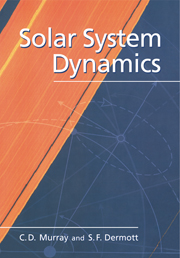Book contents
- Frontmatter
- Contents
- Preface
- 1 Structure of the Solar System
- 2 The Two-Body Problem
- 3 The Restricted Three-Body Problem
- 4 Tides, Rotation, and Shape
- 5 Spin–Orbit Coupling
- 6 The Disturbing Function
- 7 Secular Perturbations
- 8 Resonant Perturbations
- 9 Chaos and Long-Term Evolution
- 10 Planetary Rings
- Appendix A Solar System Data
- Appendix B Expansion of the Disturbing Function
- References
- Index
Appendix A - Solar System Data
Published online by Cambridge University Press: 05 June 2012
- Frontmatter
- Contents
- Preface
- 1 Structure of the Solar System
- 2 The Two-Body Problem
- 3 The Restricted Three-Body Problem
- 4 Tides, Rotation, and Shape
- 5 Spin–Orbit Coupling
- 6 The Disturbing Function
- 7 Secular Perturbations
- 8 Resonant Perturbations
- 9 Chaos and Long-Term Evolution
- 10 Planetary Rings
- Appendix A Solar System Data
- Appendix B Expansion of the Disturbing Function
- References
- Index
Summary
And he that calls on thee, let him bring forth
Eternal numbers to outlive long date.
William Shakespeare, Sonnet XXXVIIIIntroduction
This appendix contains lists of important astronomical constants, information about the use of the Julian date, orbital data, and physical properties of the known planets and satellites, as well as limited information about some of the minor bodies that make up the solar system.
The data are taken from a number of sources including The Astronomical Almanac for the Year 1995 (HMSO, 1994), The Explanatory Supplement to the Astronomical Almanac (Seidelmann, 1992), and the article by Yoder (1995) and the references therein. The data from the first of these publications is reproduced with permission from HMSO. Other sources of data are indicated in the appropriate sections.
Astronomical Constants
In 1976 the International Astronomical Union (IAU) defined a system of astronomical constants. The IAU system has units of length (the astronomical unit), mass (the mass of the Sun), and time (the day). If the units of length, mass, and time are the astronomical units of these quantities then the astronomical unit of length is the length for which the Gaussian gravitational constant k has the value 0.01720209895. In effect, if the gravitational constant G is expressed in the astronomical units of length, mass, and time then k2 = G. Some of the 1976 IAU constants are given in Table A1.1.
- Type
- Chapter
- Information
- Solar System Dynamics , pp. 526 - 538Publisher: Cambridge University PressPrint publication year: 2000

